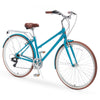Understanding Gear Ratios And Why They Matter
Copy Link
http://www.sixthreezero.com/blogs/bike-advice/understanding-gear-ratios-and-why-they-matter

The gears on a bike can be confusing. But, once you get the hang of how they work and know how to use them to optimize your ride, it’s all fun from there.
Getting to know the ins and outs of gear ratios is especially challenging for new cyclists. In addition to learning the difference between types of gears, deciphering how they work is a key step to enjoying your bike’s potential to the fullest.
Here is a handy guide to understanding gear rations and why they matter.
Types of Gears
Before we talk about how a 3-gear bike works or the benefits of 7-speed bike gears, let’s take a look at the types of gears you’ll commonly find on a bicycle. When deciding between a beach cruiser with gears or a hybrid bike with gears, consider that your options will be cycles with:
- A single-speed gear
- Fixed gears
- Derailleur Gears
- Hub Gears
What Makes a Gear System?
Nearly all bikes with gears will have pedals connected to a chainring via crank arms. The 2 crank arms connect through the bike’s frame by a shaft called a bottom bracket axle.
The bike chain in a gear system is always ½ pitch (this is the distance between links) and it varies in width according to the gear type. One or more sprockets (toothed rings) attach to the bike’s rear wheel.
Gear Rations
The simplest way to understand gear ratios is to think about how many times the wheel on the back of your bike rotates for each crank arm (pedal) turn.
If you have a chainring that has 30 teeth and you have a sprocket with 30 teeth, there’s no variance between the two. This means that one full pedal revolution results in one full wheel revolution (a ratio of 1 to 1 (1:1).
Bikes with chainrings that have 30 teeth and a sprocket that has 10 teeth have a chainring that’s 3 times the size of the sprocket. In this case, one full pedal revolution results in 3 full wheel revolutions – a ratio of 3 to 1 (3:1).
Why does this matter? Well, when you’re traveling on different terrain and on varying degrees of slope (or no slope), understanding gear ratios helps you best cover your ground.
A bike with a 7:1 gear ration will travel 7 times the distance of a bike with a 1:1 gear ratio for each revolution of the pedal. Do you see how efficient this type of cycling can be?
If you’re ascending on a steep landscape, you’ll want to select the lowest gear (the smallest chainring). Traveling on a moderate or steep descending landscape means you should select a higher gear. Most normal rides are perfect with the mid-gear selected.
Want to learn more about gears and gear ratios? Check out some of our articles on the benefits of bikes with gears. Ready to try a bike with gears? Some of our most popular geared bicycles include the sixthreezero Paisley 3 Speed Women's 26" Beach Cruiser Bike and sixthreezero Scholar 7 Speed Women's 26" Beach Cruiser Bike.
Join our Journey Club to uncover new and exciting ride locations around the globe!
Take our Free Body Fit Questionnaire
Similar Articles
If you fall outside the average measurements of most folks, you know that sizing items are...
Getting started when biking uphill, it's going to be hard when you start off, especially if...
Now that spring is here, it's sunny, you definitely want to get that vitamin D and...















